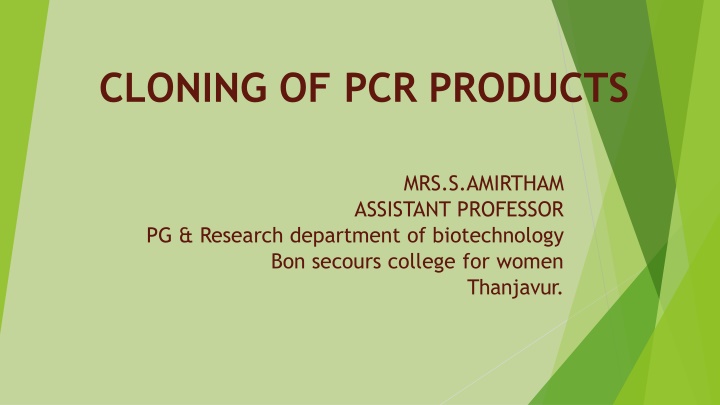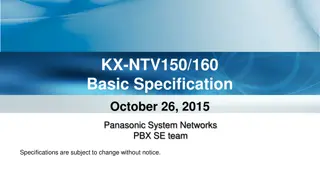
PCR Cloning: An Innovative Approach in Genetic Manipulation
Explore PCR cloning, a rapid method for cloning genes that surpasses traditional techniques by amplifying and ligating DNA fragments through the polymerase chain reaction. Learn about its discovery, working principles, types, and applications in genetic research.
Download Presentation

Please find below an Image/Link to download the presentation.
The content on the website is provided AS IS for your information and personal use only. It may not be sold, licensed, or shared on other websites without obtaining consent from the author. If you encounter any issues during the download, it is possible that the publisher has removed the file from their server.
You are allowed to download the files provided on this website for personal or commercial use, subject to the condition that they are used lawfully. All files are the property of their respective owners.
The content on the website is provided AS IS for your information and personal use only. It may not be sold, licensed, or shared on other websites without obtaining consent from the author.
E N D
Presentation Transcript
CLONING OF PCR PRODUCTS MRS.S.AMIRTHAM ASSISTANT PROFESSOR PG & Research department of biotechnology Bon secours college for women Thanjavur.
Introduction PCR Cloning differs from traditional Cloning in that the DNA fragment of interest, and even the vector, can be amplified by the polymerase chain reaction (PCR) and ligated together, without the use of restriction enzymes. A little amount of DNA isnecessary.
PCR cloning is rapid method for cloning genes, and is often used for projects that require higher throughput than traditional cloning methods can accommodate. It allows for the cloning of DNA fragments that are not available in large amounts.
Discovery of PCR PCR was invented by kary Mullis. Born on 28thDecember 1944,kary Mullis is a noble prize winning biochemist, author and lecturer. Started working at citus corporation, California in 1973.
How PCR was invented? Thinking to use simpler method for DNA sequencing. planning to use Sanger method called dideoxytechnique . Use dideoxy bases (ie., O removed from 2prime position of carbon ring) & polymerase. Stop further addition of bases.
Working of PCR The basic protocol of a PCR require following ingredients : Template DNA Pair of primers DNA polymerase (usuallyTaq polymerase) dNTPs(ie., four bases A T G C) Some ions and salts are also used.
Types There are many different types of polymerase chain reaction on the basis of their principles. Real time PCR Reverse transcriptase PCR Quantitative real-time PCR Multiplex PCR Nested PCR
1.Real time PCR Real time PCR is introduced by Higuchiand fellows in 1992. In Real time PCR we find out anaccurate quantification of DNA sequence in a complex mixture. Real time PCR is divided into twotypes: Non-specific detection using binding dyes Specific detection target specific probes.
Specific detection target specific probes Oligonucleotides probe are used for the specific detection. Oligonucleotides are labelled with fluorescent dye. Different types of probe are used: Taq man probes FRET hybridization probes Molecular beacons.
Non-specific detection using binding dyes In real time PCR,DNA binding dyes are used as fluorescent protein work as reporter molecules. Fluorescent reporter molecules increase as the reaction proceeds. Different dyes are used but SYBR green is commonly used dye in real time PCR. It is the specific dowble stranded DNAdye.
2.Reverse Transcriptase PCR Reverse transcriptase PCR is a modified technique used for the detection of RNA expression In this technique,RNAis used for rather than DNA. In Real time PCR, transcriptase enzyme is used for converting mRNA into cDNA. DNA strands are now denatured then add two primers for the synthesis of cDNA.
Procedure PCR nucleotide sequence of child and suspected father is run on the gel by applying electric current. The nucleotide sequence of PCR products may resemble to either father 1 or 2. If the sequence match this show the relatedness between the child and the parent.
PCR Mechanisms Three stages : Denaturation 90 c-100 c Denaturation of DNA Annealing 30 c-65 c primer binds to both strands,antiparallel Extension 60 c-75 c Addition of dNTPs at 3prime end.
PCR applications Paternity Testing: Genetic material is inherited from both parents,half from mother and half from father. DNA sample from buccal saliva or blood is collected and extracted from the alleged child. Then the extracted DNA is subjected toPCR, thousands of copies of amplified DNA is obtained.
Mutation detection in inherited disease Any point mutation,a deletion or an insertion and expanded tandem trinucleotide repeat can be detected by PCR. Somatic mutations in oncogenes or tumor repressor genes can also be detected by PCR with primers flanking the insertions or deletions.
T-vectors T-vectors pMD20 and pMD19: pMD20 & pMD19(simple) T-vectors are linearized PCR Cloning vectors (cleaved by EcoRV) with single 3 -terminal thymidine residues (dT) at both ends. These T- overhangs at the Cloning site improve the efficiency of ligation of Pcr products that CONTAIN dA overhangs. The inclusion of lacZ allows screening for the detection of successful libations.
Proofreading enzymes A repair mechanism that helps to ensure faithful DNA replication in living cells. It isa function of the enzyme DNA polymerase, which catalyses the replication process. This enzyme identifies and excises mismatched bases at the end of the growing strand, leaving the end free to accept the correct nucleotide instead, thereby restoring the correct complementary base sequence.
Why are Proofreading enzymes Important? It allows the enzyme to check each nucleotide during DNA synthesis and excise mismatched nucleotides in the 3 to 5 direction. The Proofreading domain also enables a polymerase to remove unpaired 3 overhanging nucleotides to create blunt ends.
Different types of proofreading Bilingual proofreading Monolingual proofreading Stylistic proofreading Pre-print proofreading Other types of proofreading.
How do proofreading enzymes work? DNA polymerases are the enzymesthat build DNA in cells. During DNA replication (copying),most DNA polymerase can Chech their work with each base that they add. This process is called proofreading... Polymerase uses 3 to 5 exonuclease activity to remove the incorrect T from the 3 end of the new strand.
Polymerase adds an incorrect nucleotide to the new strand of DNA Polymerase detects th bases are mispaired. Polymerase uses 3 - 5 exonuclease activity to remove incorrect nucleotide.
PCR in gene recombination Gene splicing by overlap extension (gene SOEing) is a sequence independent method for site-directed mutagenesis and recombination of DNAmolecules. It is based on the idea that a PCR product can be engineered by adding or changing sequences at its ends so that the product can itself be used to prime DNA synthesis in a subsequent overlap extension reaction to create mutant or recombinant molecules.
Deletion The PCR mediated plasmid DNAdeletion method is a simple approach to delete DNA sequence from plasmids using only one round of PCR, with two primers, and without ligation or purification prior to the invivo recombination. By using only PCR, the method is sequence independent and, as shown in this study, is applicable to various sizes of plasmids.
Addition Before adding the overhangs it is very important to remove all the Proofreading DNA polymerase bypurifying the PCR product carefully (eg.,with a commercial PCR purification kit orphenol extraction and DNA precipitation) ;since the Proofreading activity of DNA polymerase will degrade the A overhangs, creating blunt ends again.
Site specific mutagenesis Site directed mutagenesis is an in vitro method in a known sequence. While often performed using PCR based methods, the availability of custom designed, synthetic, double stranded DNA (dsDNA) fragments can drastically reduce the time and steps required to obtain the same sequence changes. primers designed with mutations can introduce small sequence changes, and primer extension or inverse PCR can be used to achieve longer mutant regions.




